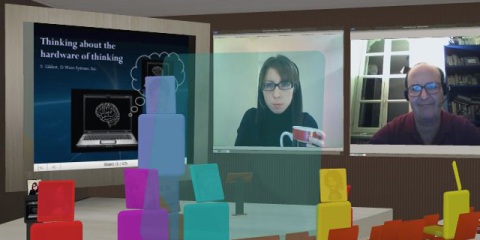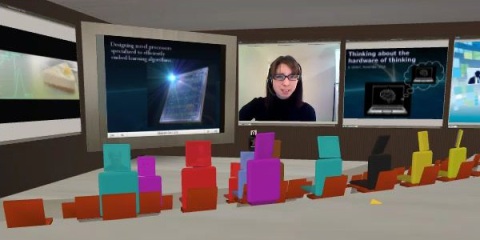Suzanne Gildert gave a talk in Teleplace on “Thinking about the hardware of thinking: Can disruptive technologies help us achieve uploading?” on November 28, 2010, at 10am PST (1pm EST, 6pm UK, 7pm continental EU).
This was a revised version of Suzanne’s talk at TransVision 2010, also inspired by her article on “Building more intelligent machines: Can ‘co-design’ help?” (PDF). See also Suzanne’s previous Teleplace talk on “Quantum Computing: Separating Hope from Hype“.
For those who could not attend we have recorded everything (talk, Q/A and discussion) on video. There are 2 different videos on blip.tv:
VIDEO 1 – 600×400 resolution, 1 hour 4 min
VIDEO A – 600×400 resolution, 1 hour 4 min, taken (mostly) from a fixed point of view by Antoine van de Ven
NOTES: To download the source .mp4 video files from blip.tv, open the “Files and Links” box.
Thinking about the hardware of thinking: Can disruptive technologies help us achieve uploading?
S. Gildert, Teleplace, 28th November 2010
We are surrounded by devices that rely on general purpose silicon processors, which are mostly very similar in terms of their design. But is this the only possibility? As we begin to run larger and more brain-like emulations, will our current methods of simulating neural networks be enough, even in principle? Why does the brain, with 100 billion neurons, consume less than 30W of power, whilst our attempts to simulate tens of thousands of neurons (for example in the blue brain project) consumes tens of KW? As we wish to run computations faster and more efficiently, we might we need to consider if the design of the hardware that we all take for granted is optimal. In this presentation I will discuss the recent return to a focus upon co-design – that is, designing specialized software algorithms running on specialized hardware, and how this approach may help us create much more powerful applications in the future. As an example, I will discuss some possible ways of running AI algorithms on novel forms of computer hardware, such as superconducting quantum computing processors. These behave entirely differently to our current silicon chips, and help to emphasize just how important disruptive technologies may be to our attempts to build intelligent machines.
This talk is part of the ASIM Expert Series (see carboncopies.org). See also Suzanne’s post and the Event on Facebook.
 |
Dr. Suzanne Gildert is currently working as an Experimental Physicist at D-Wave Systems, Inc. She is involved in the design and testing of large scale superconducting processors for Quantum Computing Applications. Suzanne obtained her PhD and MSci degree from The University of Birmingham UK, focusing on the areas of experimental quantum device physics and superconductivity. |
teleXLR8 is a telepresence community for cultural acceleration. We produce online events, featuring first class content and speakers, with the best system for e-learning and collaboration in an online 3D environment: Teleplace. Join teleXLR8 to participate in online talks, seminars, round tables, workshops, debates, full conferences, e-learning courses, and social events… with full immersion telepresence, but without leaving home.






0 Responses to “Suzanne Gildert on Thinking about the hardware of thinking: Can disruptive technologies help us achieve uploading?, Teleplace, 28th November 2010”